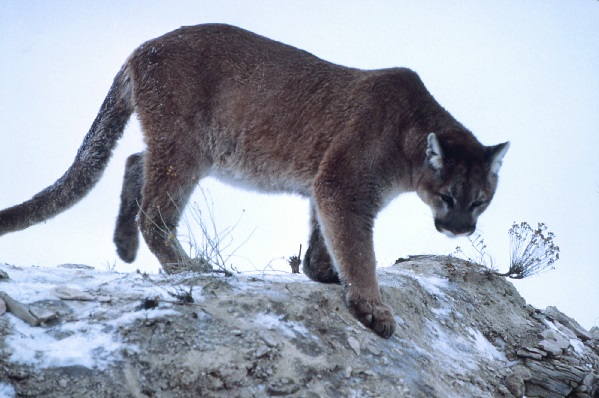NORTH FORK – Residents have been on guard over the past several weeks after a mountain lion kills 14 head of sheep and goats in the North Fork area.
A resident who owns a rental home behind Goodwin Lumber says the lion came onto his property, slaughtered seven of his sheep and devoured them.
“All that was left was their bottom teeth and some fluffs of hair,” said Gene Vierra of the carnage left by the lion.
Vierra called the wildlife trapper from the USDA Wildlife Services to capture the lion. However, the big cat apparently walked into the trap, snagged some of the bait, and walked out without the trap being tripped, says Vierra, who notified the nearby North Fork School about the presence of the large predator. School personnel kept everyone inside in an abundance of caution, though they did not see the lion on the property themselves.
A week or so later, seven Angora goats owned by David and Julie Konno were killed on their property, which is near the school, above the North Fork Cemetery.
On Monday night, Mar. 30, the lion attacked and killed one of Julie’s beloved goats, and left it down in a corner of the pasture where it could not be seen by Diann Miller, who was tending to the animals while Dave and Julie were out of town. The cat returned on Tuesday night, and with bites to the neck of each, killed the remaining six goats, leaving them dead but not eating them.
Diann’s husband Jere was issued a depredation permit by the California Department of Fish and Wildlife (CDFW), as was Gene Vierra, allowing them to shoot the lion. However, neither was successful in spotting the big cat in the 10 days allotted for the permit, which can be reissued and is free of charge.
Hunting mountain lions in California is illegal, however a depredation permit can be issued to take a specific lion that is killing livestock or pets, and/or to preserve the public safety.
After the failure to trap the lion, Vierra called the USDA again to have the trapper return. He was told that the contract with Madera County for this type of services is only good nine months out of the year due to budget constraints, and as of April 1st, there would be no money available for trapping until the beginning of July.
California Department of Fish and Wildlife biologist Tim Kroeker came out to investigate the incidents and issue permits, and notes the distinction between his agency and the federal USDA Wldlife Services with which the County has a contract.
“Fish and Wildlife does not trap mountain lions for depredation,” says Kroeker in response to the concerns expressed by Mr. Vierra. “We don’t provide that service; our responsibility is to make sure he can get a permit if he needs one.”
They also will not come out and kill the animal, and until the contract between the County and the USDA comes back into effect, there is nothing any government agency can do other than allow the resident to dispatch the lion by permit.
Kroeker encourages anyone who lives in the foothills and keeps small livestock to lock them up at night in some type of structure that has sturdy sides and a good roof.
“Because of all the predators we have in the area, that is the best kind of preventative measure,” he says. “Even if you’re not keeping animals, I encourage everyone to keep vegetation down around your house for a clear line of sight, and if you’re going out at night, have good lighting around your home.”
Kroeker says that the presence of mountain lions in any area is determined by natural cycles.
“There are lions that are in the mid-elevations of the foothills year round, and others that are semi-migratory and follow the deer,” he says. “It depends on the habitat conditions and whether it is a male or female as to how far they travel.”
Mountain lions are basically nocturnal, and with the proliferation of security and game cameras, many people are just now learning that lions live in their neighborhood.
Mountain lion attacks on humans are rare. According to CDFW, there have been only 16 verified mountain lion attacks on humans in California since 1890, six of them fatal. The last documented attack occurred in January 2007, in Humboldt County.
As for the big cat roaming the North Fork area, Julie Konno says she has seen fleeting glimpses of it disappearing into the brush along the road as recently as a few days ago, and that a friend saw one loping down the road near the Indian Creek Trailer park, five miles east of town on Road 225.
To learn more about mountain lions, the CDFW site has an informative list of FAQs on their website at https://www.dfg.ca.gov/wildlife/lion/lion_faq.html.
(Mountain lion photo – Wikipedia)





I saw a large mountain lion with dark pointed fur on Rd 432 at 430 am on Apr 6th. Not sure if its the same one but I got real good look in the headlights as it came down a bank into the road in front of me, ran along the road a few bounds, then turned and went back up the bank. I almost hit it, glad I was going so slow!